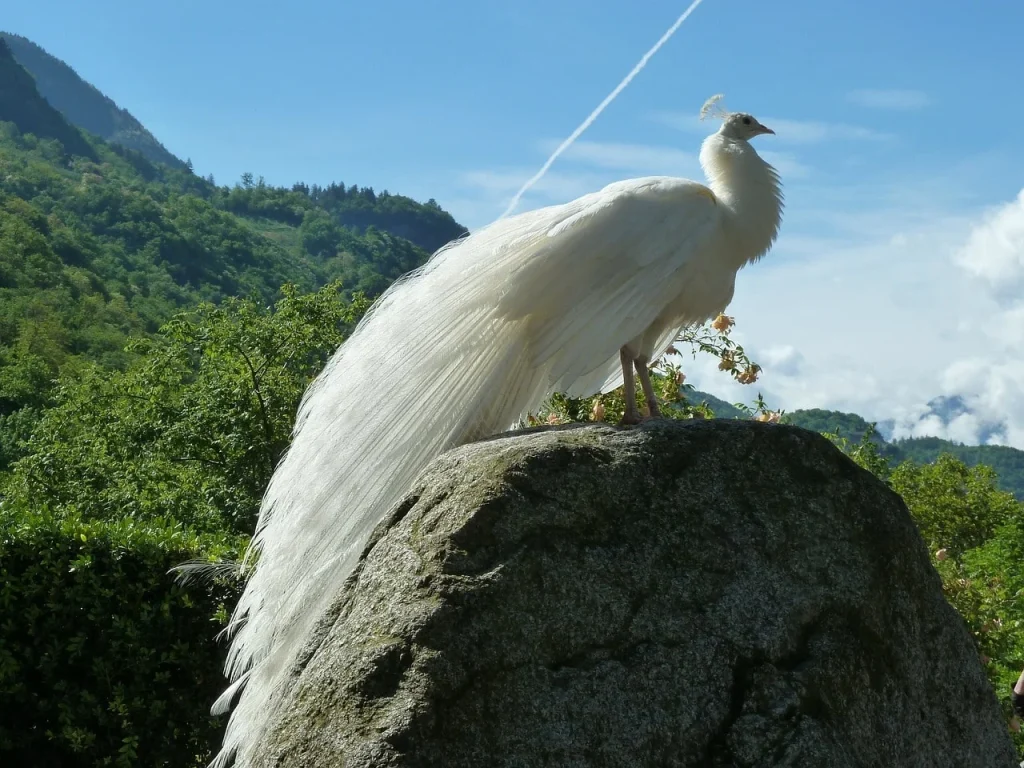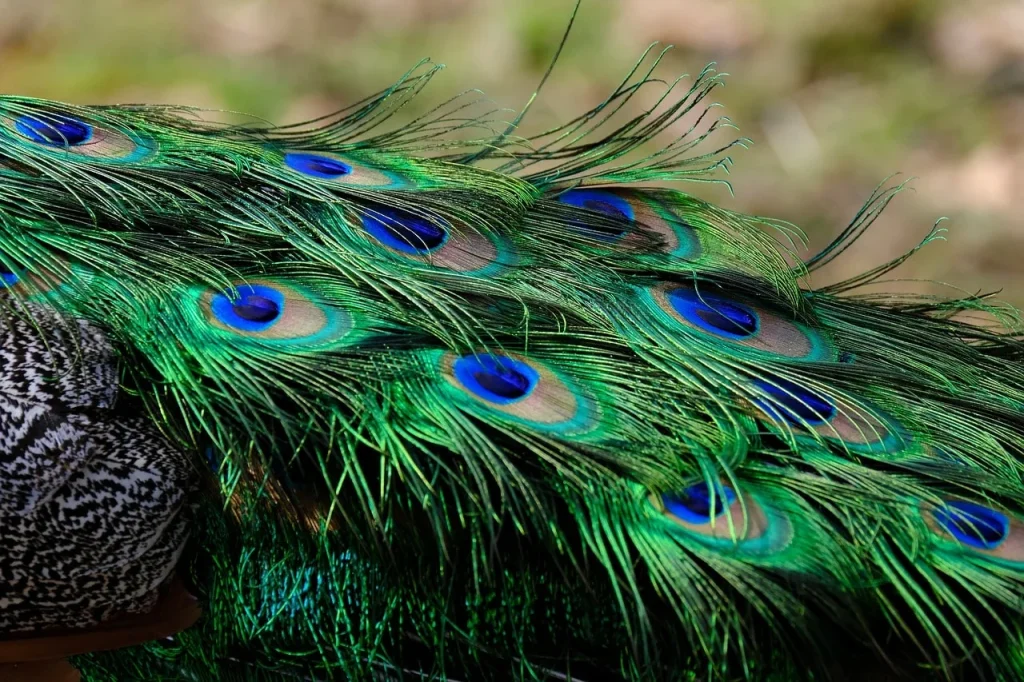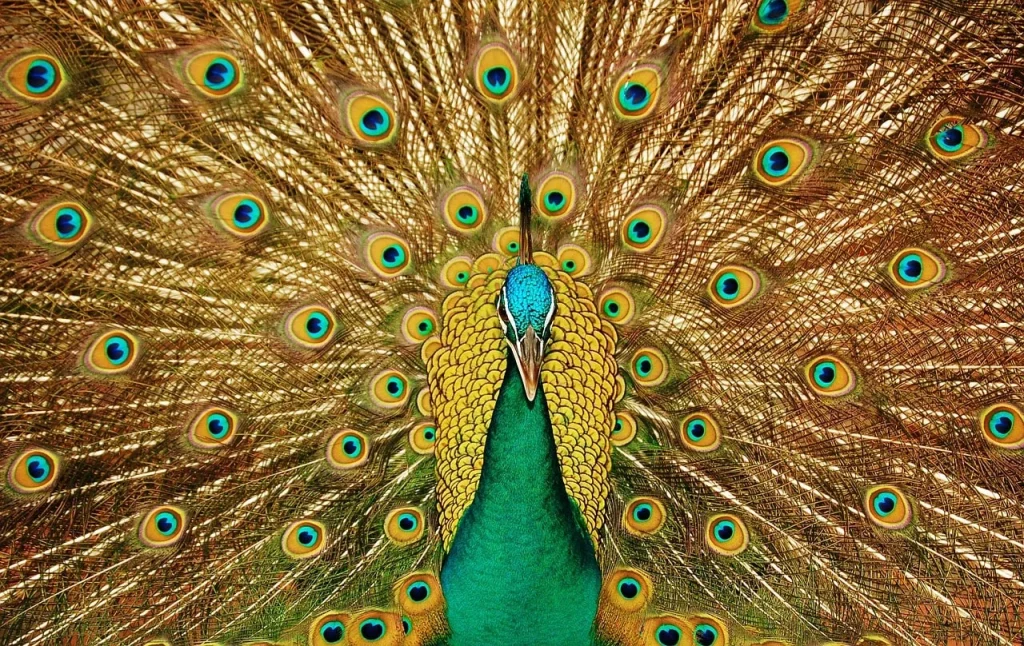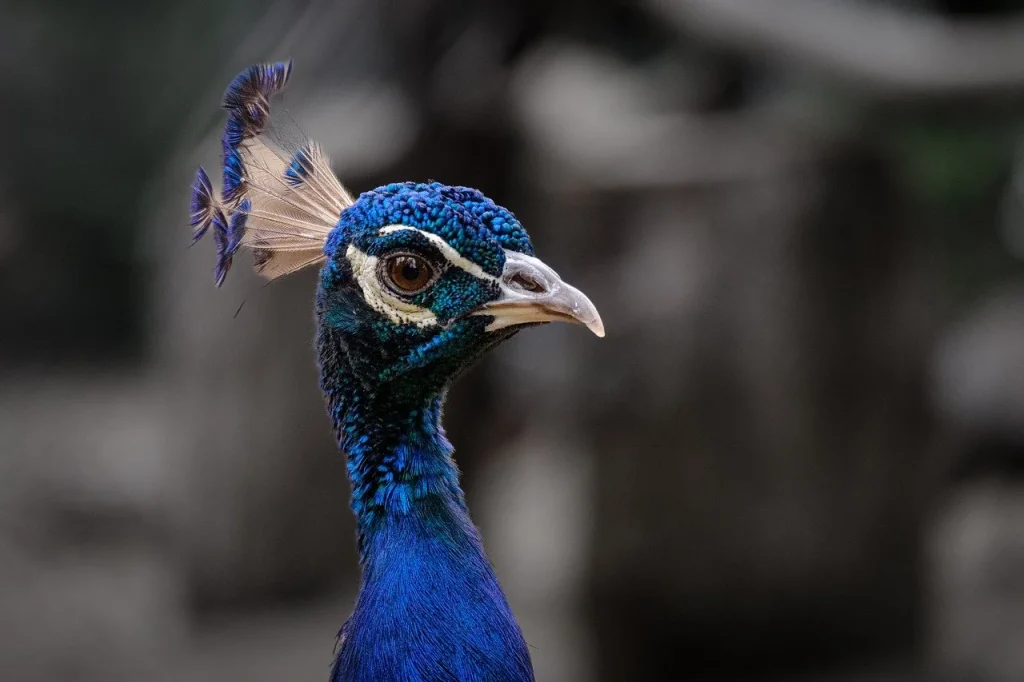Peacocks are nature’s show-offs, flaunting feathers that could make any fashion designer green with envy. Today, we’re taking a closer look at these spectacular birds, uncovering some fun facts that highlight their charm and complexity.
From their unique courtship dances to their ability to ‘fake‘ a snake hiss, peacocks are full of surprises. Ready to learn which fact will amaze you the most?
The pride of the peacock is the glory of God.
William Blake
Peacock Facts
Discover the world of peacocks with facts that reveal their majestic allure and unique behaviors. Stay tuned for a quiz at the end to test your expertise!
- The males can have up to 200 tail feathers, each adorned with vibrant eye spots.
- Their dazzling tail display is known as a “train” and can be up to 6 feet long.
- They are capable of producing 11 different vocal calls, each with a specific purpose.
- Only three species exist: the Indian, the Green, and the Congo.
- The Green variety, native to Southeast Asia, is considered the most endangered species.
- Despite their extravagant plumage, they are strong fliers and can reach the tops of tall trees.
- When threatened, they can fly short distances at speeds of up to 16 km/h (10 mph).
- In Hindu mythology, they are associated with the god Kartikeya, symbolizing power and beauty.
- Their spectacular train feathers are molted and regrown annually.
- The eye spots on their tail feathers are believed to deter predators through a phenomenon known as aposematism.
- Females, known as peahens, choose their mates based on the quality and quantity of eye spots on the males’ trains.
- They have a unique courtship dance, where males fan out their trains and make a rattling sound to attract females.
- Their iridescent blue and green feathers are not due to pigments but structural coloration, which reflects light.

- Ancient Romans kept them as pets and considered their meat a delicacy.
- They can live up to 20 years in the wild and even longer in captivity.
- These birds are omnivores, eating a diet that includes insects, plants, and small reptiles.
- They have a special gland near their eyes that helps produce oil to keep their feathers in pristine condition.
- Their distinctive crest on top of their heads is made up of wire-like feathers known as the crown.
- They are known for their loud, high-pitched call, which can be heard up to 1 mile away.
- In some cultures, their feathers are believed to bring good luck and ward off evil spirits.
- In captivity, they can become quite tame and even recognize their human caregivers.
- The males do not develop their full plumage until they are around three years old.
- They engage in a behavior called “anting,” where they allow ants to crawl on their feathers to remove parasites.
- They have strong legs and sharp spurs, which they use to defend themselves against predators.
- Peachicks, the young, are able to fly within a week of hatching.
- They are native to the forests of South Asia but have been introduced to many other parts of the world.
- Unlike many other birds, they do not migrate and are sedentary, remaining in the same area year-round.
- Their nests are typically simple ground scrapes, often hidden in dense vegetation to protect their eggs.

- They are known to be highly social birds, often seen in small groups called “parties” or “bevy.”
- Their vibrant plumage has inspired artists and designers for centuries, appearing in various forms of art and fashion.
- They are revered in many cultures and often appear in folklore and mythology as symbols of beauty and immortality.
- In some parts of India, they are protected by law due to their cultural significance.
- Their feathers have microscopic crystal-like structures that create their vivid colors through light interference.
- They have a unique way of walking, called a “treading” gait, where they lift their feet high and place them down gently.
- They can swim, although they rarely do so, preferring to stay on land or in trees.
- During the breeding season, males can mate with multiple females, a behavior known as polygamy.
- The sound of their call is often mistaken for a human scream, adding to their mysterious aura.
- They have been depicted in ancient Greek and Roman mosaics and were considered sacred to the goddess Hera.

- These birds are excellent at camouflage; their dull brown chicks blend seamlessly into their surroundings to avoid predators.
- In Japan, they are a symbol of longevity and are often depicted alongside cranes in traditional art.
- Their eyes are equipped with both rod and cone cells, allowing them to see in low light and in color.
- The vibrant “eye” pattern on their feathers can appear to follow viewers, an effect known as “biological motion.”
- They are one of the few bird species known to eat venomous snakes, such as cobras.
- Females can lay between 3 to 12 eggs per clutch, and they incubate them for about 28 days.
- Their droppings have been used in traditional medicine for various treatments, including stomach ailments.
- Their name originates from the Latin “pavo,” which means “peafowl.”
- Despite their size, they are surprisingly agile and can maneuver quickly to escape predators.
- Some cultures believe that having a feather in one’s home can bring peace and prosperity.
- They are often used in agriculture to control pests, as they feed on insects and small animals that can damage crops.
- They have been known to show signs of empathy, consoling distressed members of their group.
Peacock Myths

Now that we’ve explored the facts about peacocks, let’s dive into separating myths from reality.
- Peacocks Can’t Fly
They are actually capable of flight, though they are not long-distance fliers. They typically fly to escape danger or to roost in trees. Their flights are more like powerful, short bursts to reach higher ground rather than sustained flight. - Only Male Birds are Called Peacocks
The term “peacock” specifically refers to the male bird; females are called peahens, and together, they are known as peafowl. Peacocks are renowned for their colorful plumage, while peahens are more subdued in color. - Peacocks Display Their Tails to Attract Females Only
While displaying their magnificent tails primarily serves to attract mates, peacocks also fan their feathers as a show of dominance and to deter predators by making themselves appear larger and more threatening. - Peacocks’ Tail Feathers Have Eyespots to Mimic Predators
The eyespots on peacocks’ tail feathers do not serve to mimic predators but rather to attract peahens through their size, symmetry, and vibrant colors. These eyespots are more about beauty and visual appeal in the mating ritual. - Peacocks are Native Only to India
While they are native to India and parts of South Asia, they have been introduced and have adapted to various other parts of the world. Today, wild populations can be found in areas like North America and Australia, thriving in diverse environments.
Peacock Quotes

We continue to the next section, the quotes. Feel free to share more in the comments so I can add them to the list.
A peacock has too little in its head and too much in its tail.
Danish Proverb
This Danish proverb humorously critiques someone who may be all show and no substance, using the peacock as a metaphor.
I am like a peacock who rests on his feathers. And I ask no one to understand me.
Khalil Gibran
Khalil Gibran uses the image of a peacock to symbolize self-reliance and the acceptance of being misunderstood.
Be like a peacock and dance with all of your beauty.
Debasish Mridha
Debasish Mridha encourages everyone to embrace and express their unique qualities boldly and beautifully, just as a peacock would.
The peacock has colorful feathers, harmonious sounds, and graceful dances. Yet, its feet are ugly. Everything has its flaws.
Chinese Proverb
This Chinese proverb teaches the lesson of humility and acceptance, noting that even the most beautiful creatures like peacocks have imperfections.
Nature’s great masterpiece, an elephant; the only harmless great thing, the giant of the jungle, is more like a peacock than it is like anything else.
John Donne
John Donne marvels at the majesty of nature’s creations, comparing the grandeur of an elephant to the beauty of a peacock in a surprisingly poetic way.
Peacock FAQ

We’ve explored the allure of peacocks through various quotes. Now, as we move into the FAQ section, remember that a quiz awaits. Read carefully if you want to get a perfect score.
- Are peacocks aggressive?
Generally, they are not aggressive, but they can display territorial behaviors during the breeding season. Males may become more assertive or defensive if they feel their space or mating opportunities are threatened. - Can peacocks fly?
Yes, they can fly, albeit not very far or high. They primarily use their flight capabilities to escape predators and to roost in trees, where they can be safe from ground dangers. - How do peacocks mate?
They mate through a fascinating display ritual. The male peacock spreads his spectacular tail feathers to attract females. This display, coupled with strutting and sometimes calls, aims to impress potential mates and is crucial for their mating success. - Are peacocks good pets?
They can be kept as pets, but they are not suitable for everyone. They require a lot of space to roam, and their loud calls can be disruptive. They also need a secure environment to protect them from predators. Potential owners should consider their environment and ability to meet these needs before deciding to keep peacocks as pets. - Can peacocks live with chickens?
They can live with chickens, but care should be taken to ensure both species have enough space and resources. There can be issues with food competition and disease transmission, so it’s important to monitor their health closely and provide adequate care for both bird types.
Peacock Trivia

Welcome to our peacock-themed quiz! Just a heads up, if you don’t answer any questions correctly, you might wake up tomorrow with an irresistible urge to strut around with your feathers displayed!
Conclusion
To finish, let’s not forget the enduring allure of peacocks. These birds aren’t just beautiful; they’re symbols of grace and mystery in many cultures around the world. Their presence is a reminder of the intricate and interconnected nature of our ecosystem.
As we move forward, let us hold onto the fascination and wonder that peacocks inspire in all who behold them. Till next time, stay curious and explore more. Cheers.
1 Source Used For This Article

